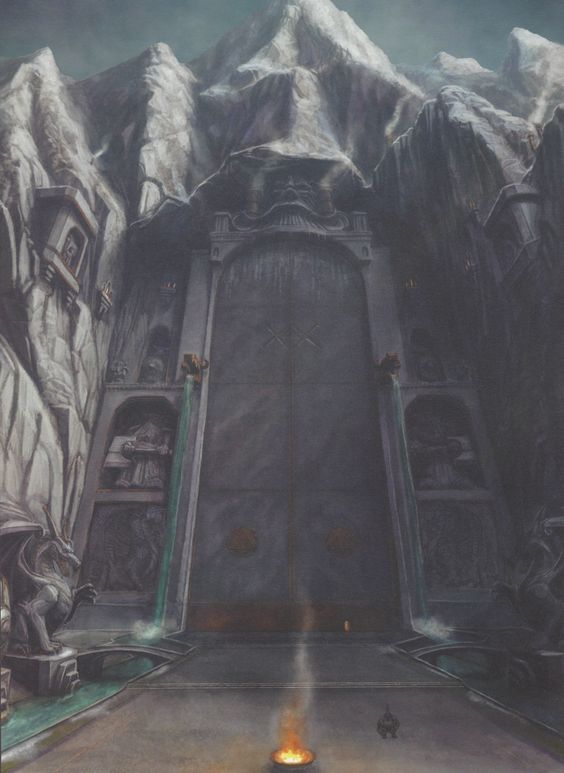The High Gate
The High Gate, originally, was never meant to hold civilians, but things changed as they began to accommodate soldiers. A granary was built to store food for the barracks, stables were placed for messengers, the horses needed grain and water so a gutter system was designed from the mountain rock, pools formed from the rock with enough to spare for the soldiers and more.
Purple pears, which were green vines that produced a fist sized fruit with black and purple stripes four times in a year, flourished on the harsh rock face which produced a surplus.
That was just the beginning, they grew more vines and imported rams from Edudweni. They all flourished, so did an impressive supply of potatoes, more than enough to sustain the soldiers of the High Gate. Sustenance through the most savage of wars and the most drawn out of sieges.
Then someone, history was mute on sex, asked. 'There's allot of space between these walls. Let us add to this simple barracks, why not improve it as a half way point?'
This didn't go down well with the king of the time. That is, until someone else noted that there was potentially money to be made from it. The first to rise were trade spaces, which seemed simple enough.
New weapons made from better steel, stronger woods, personal and more balanced weapons and tools. The traders would come, the traders would go. New clothes were offered, plus jewels and trinkets for wives and children for the soldiers who would spend months away before they could seen them once again.
A soldier had a brother who baked, and the first bakery was built. A trained butcher was given land, so those visiting the Keep could eat well before coming upon the Keep itself instead of suffering with the food of the lowly soldiers.
Naturally a butcher needed meat and a baker flour but even combined they weren't anything without ale and beer fit for a king.
The walls grew, space was opened further, masterful engineers expanded into the mountains themselves, using magic to ensure the mountain never fell upon the gates.
With the introduction of ale followed the introduction of disorder, the kind of disorder which could be found in a bird's eyes of view any crowded city or of a live flame, a disorder otherwise known as life.
The tower grew into a city, bunk houses were sold and were turned into homes, rooms which held little more than beds and a cupboard now held the lively hoods of a hundred, a hundred become a thousand and finally one hundred thousand.
At present the number was better marked at several hundred thousand. A seven meter wall became the third most populated city in Mutale.
This single story resonated with Nceba, even as he walked back to the High Gates the story hung in the back of his mind. The true written story held no life within it. It held only names and dates, meaningless to those willing to listen and learn, more so for those who just wanted a good story. Though with little doubt he knew that at one point someone had had the basic foresight that most men had lacked. The idea that fertile ashen soil harvested by simple farmers and ram herders, had started it all was one that brought his mind to his own personal story, the idea of something small becoming something big.
Demographics
- Humans 85%
- Black Air Raiders. 1%
- Sicgawu people
- Tritholus people
- Hibidu people
- Abesante people
- Nizinja people 4%
- Lovani people 0.1%
- Segogko people 0.5%
- Corsair people
- Isichwe people
- Nomlambho people
- Ufeleyetsimbi people
- Amambambo people
- Ilityelolwandle people
- Iisele people
- The Iiphiko EthwEthwathwa people
- Iihagu people
- Izinyoka people
- Qonqothwane people
- Ikunzi people
- Fimbili People
- Isihlennga people
- Geraamte people
- Tlou people.
- Segwagwa people.
- The Kgapa People.
- The Umlimini People.
- The Inqindi People.
- The Ngxilimbela people.
- The Umbaleki people.
- The Imosi Lehathi people 3%
- The Incanda people
- The Umlambo people
- The Dithoballo people
- The Zelelelo people
- The Ngwe People
- The Umgodi People
- The Ugqoloma people
- The Isikali People
- The Khombe People
- The Mbamba People
- The Uluthi People
- The Ngwenya People
- The Cwengo People
- The Ntlango People
- The Sefefo People 0.1%
- The Khephuza People
Population
1.5 Million
Location under




Comments